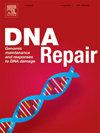Dynamics of chromatin factors RSF1, CENPS and CENPX at DNA damage sites
IF 2.7
3区 生物学
Q2 GENETICS & HEREDITY
引用次数: 0
Abstract
Chromatin has a major influence on the DNA damage response (DDR). Several chromatin-related factors participate in specialised DNA packaging during the DDR including the CENPS and CENPX histone fold proteins, also known as MHF1/2, and the chromatin remodelling factor RSF1 although their contribution has remained unclear. We defined a timeline for RSF1, CENPS, and CENPX recruitment at DNA double strand breaks (DSBs) induced in live HeLa cells by microirradiation and calibrated this to published data to clarify the potential for their involvement in the DDR. CENPS, CENPX and RSF1 are recruited with a half time of ∼100 s and removed with a half time of ∼2000 s. Enrichment for cell cycle phase revealed that this recruitment occurs in G1, S and G2 phases, but that its half time in G2 appears to be delayed and stronger than in G1. Integration of these observations with timelines for other DDR factors reveals that CENPS and CENPX recruitment occurs simultaneously immediately after ATM activation and RNF8-RNF168 activity. The removal of CENPS and CENPX is at a similar time to loading of RPA and assembly of RAD51. This places RSF1, CENPS and CENPX in the vicinity of DSBs at the time when nucleosomes are being actively remodelled during the chromatin-dependent early response to DNA damage involving pathway choice and resection, and their increased abundance at DSBs in G2 correlates with extended resection for HR.
染色质因子RSF1、CENPS和CENPX在DNA损伤位点的动态变化
染色质对DNA损伤反应(DDR)有重要影响。在DDR过程中,一些染色质相关因子参与了特殊的DNA包装,包括CENPS和CENPX组蛋白折叠蛋白,也称为MHF1/2,以及染色质重塑因子RSF1,尽管它们的作用尚不清楚。我们定义了RSF1、CENPS和CENPX在微辐射诱导的活HeLa细胞DNA双链断裂(DSBs)中募集的时间线,并将其与已发表的数据进行校准,以阐明它们参与DDR的可能性。CENPS、CENPX和RSF1的招募时间为~ 100 s,去除时间为~ 2000 s。细胞周期期的富集表明,这种募集发生在G1、S和G2期,但其在G2期的一半时间似乎比G1期延迟且更强。将这些观察结果与其他DDR因素的时间轴相结合,发现在ATM激活和RNF8-RNF168活动之后,CENPS和CENPX的招募同时发生。CENPS和CENPX的去除与RPA的加载和RAD51的组装同时进行。这将RSF1、CENPS和CENPX置于dsb附近,此时核小体在染色质依赖的DNA损伤早期反应中被积极重塑,涉及途径选择和切除,并且它们在G2中dsb的丰度增加与HR的延长切除相关。
本文章由计算机程序翻译,如有差异,请以英文原文为准。
求助全文
约1分钟内获得全文
求助全文
来源期刊

DNA Repair
生物-毒理学
CiteScore
7.60
自引率
5.30%
发文量
91
审稿时长
59 days
期刊介绍:
DNA Repair provides a forum for the comprehensive coverage of DNA repair and cellular responses to DNA damage. The journal publishes original observations on genetic, cellular, biochemical, structural and molecular aspects of DNA repair, mutagenesis, cell cycle regulation, apoptosis and other biological responses in cells exposed to genomic insult, as well as their relationship to human disease.
DNA Repair publishes full-length research articles, brief reports on research, and reviews. The journal welcomes articles describing databases, methods and new technologies supporting research on DNA repair and responses to DNA damage. Letters to the Editor, hot topics and classics in DNA repair, historical reflections, book reviews and meeting reports also will be considered for publication.
 求助内容:
求助内容: 应助结果提醒方式:
应助结果提醒方式:


